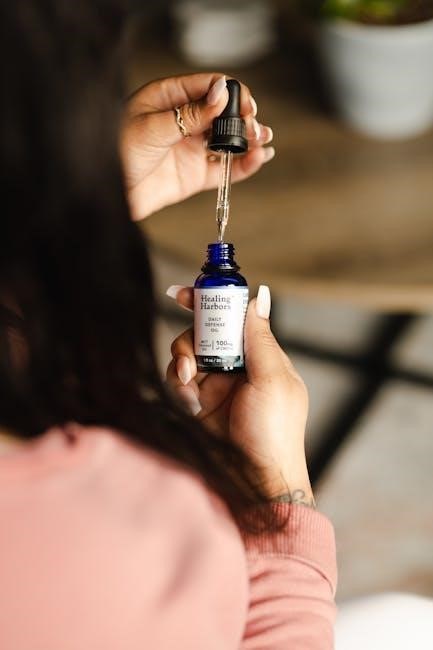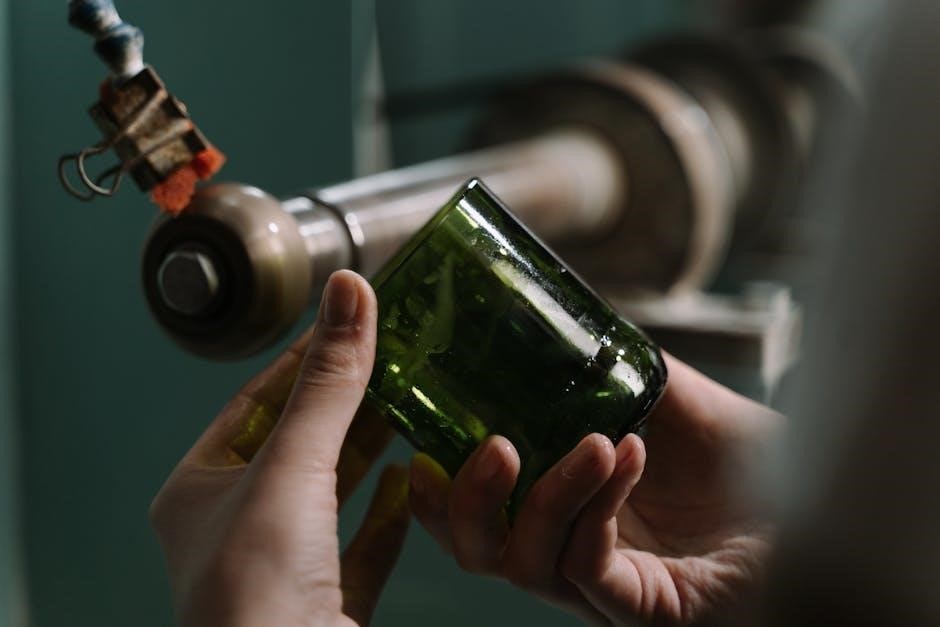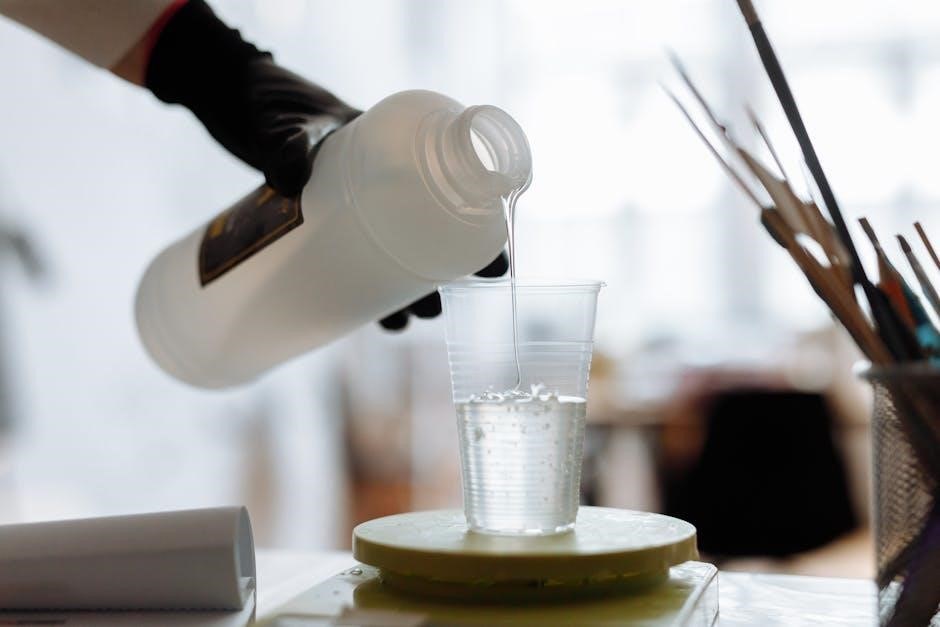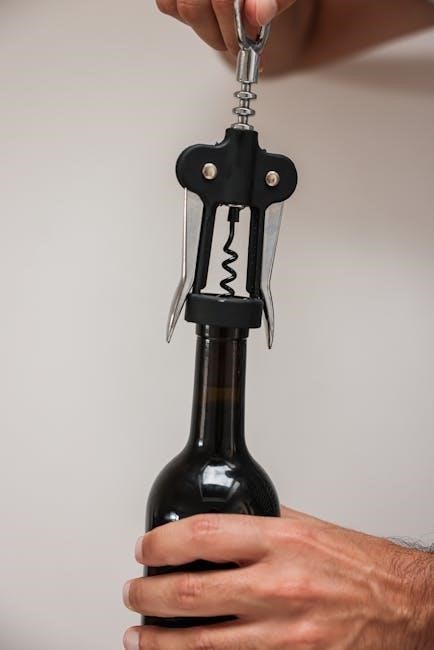Manual bottle fillers are essential tools for precise liquid filling, offering cost-effective and user-friendly solutions. Widely used in homebrewing, food, and cosmetic industries, they ensure accuracy and efficiency in various bottling processes.
History and Evolution of Manual Bottle Fillers
Manual bottle fillers have a rich history, evolving from simple, hand-operated devices to sophisticated tools. The earliest versions emerged in the 19th century, primarily used in breweries and wineries, where precise liquid measurement was crucial. These early models relied on gravity-fed systems, allowing users to pour liquids directly into bottles with minimal control. Over time, innovations like piston-operated and siphon-style fillers introduced greater accuracy and efficiency. The 20th century saw the rise of counter-pressure fillers, particularly in homebrewing, enabling better carbonation retention. Modern manual fillers incorporate durable materials and ergonomic designs, catering to both industrial and DIY applications. Their evolution reflects advancements in engineering and the growing demand for reliable, cost-effective bottling solutions across various industries.
Importance of Manual Bottle Fillers in Various Industries
Manual bottle fillers play a crucial role in diverse industries, offering precision, flexibility, and cost-effectiveness. In breweries and wineries, they enable accurate filling of bottles with minimal waste, preserving carbonation and flavor. For homebrewers, these fillers are essential for small-scale production, allowing control over the bottling process. In the cosmetic and pharmaceutical industries, manual fillers are valued for their ability to handle small batches and viscous liquids with ease; They are also popular in DIY projects, where users appreciate their simplicity and affordability. Additionally, manual fillers are often preferred for their portability and ease of use, making them ideal for startups and hobbyists. Their versatility and reliability make them indispensable tools across various sectors, ensuring efficient and precise liquid bottling solutions.
Basic Principles of Manual Bottle Filler Operation
Manual bottle fillers operate on simple yet effective principles, ensuring precise and efficient liquid transfer. Most fillers rely on gravity, manual pressure, or siphoning mechanisms to dispense liquids into bottles. The process typically involves placing the bottle under the filling nozzle, activating the valve, and allowing the liquid to flow until the desired level is reached. Some models use pistons or counter-pressure systems to maintain consistent filling volumes and prevent overflow. The key to smooth operation lies in proper alignment of the bottle and nozzle, as well as controlling the flow rate. Regular cleaning and maintenance of the valve and nozzle ensure accurate and contamination-free filling. These principles make manual fillers ideal for small-scale production, DIY projects, and industries requiring flexibility and precision in bottling processes.

Types of Manual Bottle Fillers
Manual bottle fillers come in various types, each designed for specific needs. They include gravity-fed, piston-operated, siphon-style, and counter-pressure models, catering to different liquids and industries with precision and efficiency always.
Gravity-Fed Manual Bottle Fillers

Gravity-fed manual bottle fillers operate by utilizing gravity to flow liquid from a reservoir into bottles. They are simple, cost-effective, and ideal for small-scale operations. These fillers are often preferred for their ease of use and minimal maintenance. The liquid flows through a valve or nozzle, which can be controlled manually to regulate the fill level. This type of filler is commonly used in homebrewing, small food production, and DIY projects. They are also popular for filling bottles with low-viscosity liquids, such as water, beer, or juice. Gravity-fed fillers are environmentally friendly and require no electricity, making them a sustainable choice. Their compact design and portability add to their versatility, allowing users to fill bottles in various settings. Overall, gravity-fed manual bottle fillers are a practical solution for those seeking a straightforward and efficient filling method.
Piston-Operated Manual Bottle Fillers
Piston-operated manual bottle fillers are durable and versatile tools designed for precise liquid filling. They are widely used in industries such as food, cosmetics, and pharmaceuticals. These fillers utilize a piston-driven mechanism to dispense liquids accurately. The operation involves manually activating the piston, which creates suction to draw liquid from a reservoir and release it into the bottle. This design allows for consistent filling volumes and minimal spillage. Piston-operated fillers are ideal for handling both thin and viscous liquids, making them a popular choice for various applications. Their robust construction ensures long-term reliability, and they are often easy to clean and maintain. While they may require more effort than gravity-fed models, their precision and versatility make them a valuable asset for many bottling needs. They are also cost-effective for small to medium-scale operations, offering a balance between functionality and affordability.
Siphon-Style Manual Bottle Fillers
Siphon-style manual bottle fillers are simple, efficient tools designed for precise liquid filling. They operate by creating a vacuum or suction force to transfer liquid from a reservoir into bottles. These fillers are commonly used in homebrewing, winemaking, and small-scale industrial applications. The siphon mechanism ensures minimal waste and consistent filling levels. They are particularly effective for filling bottles with tight spaces or unique shapes. Siphon-style fillers are lightweight, portable, and easy to use, making them ideal for manual operations. They are also cost-effective and require minimal maintenance. However, they may not be suitable for highly viscous liquids or large-scale production. Despite this, their simplicity and reliability make them a popular choice for many users. They are also easy to clean and sanitize, ensuring hygienic operation. Overall, siphon-style manual bottle fillers are a practical solution for small to medium-sized bottling needs.
Counter-Pressure Manual Bottle Fillers
Counter-pressure manual bottle fillers are specialized tools designed for filling bottles under pressure, particularly useful for carbonated beverages like beer or sparkling water. These fillers work by equalizing the pressure between the bottle and the liquid source, preventing excessive foam and ensuring precise filling. They are widely used in homebrewing and small-scale winemaking due to their ability to maintain carbonation levels. The process involves sealing the bottle, equalizing pressure, and then releasing the liquid into the bottle. This method minimizes waste and ensures consistent fill levels. Counter-pressure fillers are also popular in small industries for their efficiency and accuracy. While they require some skill to operate effectively, they offer excellent control over the filling process. These fillers are ideal for users who prioritize maintaining the quality and integrity of their products during bottling. Their durability and versatility make them a valuable asset for both hobbyists and professionals alike.
Key Components of a Manual Bottle Filler
Manual bottle fillers consist of a sturdy frame, a filling nozzle, a valve system, and measurement controls. These components ensure precise and efficient liquid filling in various applications.
Frame and Structural Integrity
The frame of a manual bottle filler is its foundational component, ensuring stability and durability. Typically made of stainless steel or durable plastics, it provides a sturdy base for operation. A robust frame minimizes vibration and wobbling, crucial for precise filling. Structural integrity is vital for long-term performance, especially in industrial or high-volume settings. Many fillers come with pre-assembled or easy-to-assemble frames, following detailed manuals for setup. The frame also supports the alignment of bottles and nozzles, ensuring consistent filling; Proper assembly and maintenance of the frame are essential to uphold the filler’s efficiency and accuracy over time.

Filling Nozzle and Valve System
The filling nozzle and valve system are critical components of a manual bottle filler, ensuring precise and efficient liquid transfer. The nozzle is typically designed for smooth flow and minimal spillage, often featuring an angled or rounded tip for accurate targeting. Valves, whether manual or spring-activated, control the flow of liquid, allowing users to start and stop filling with ease. High-quality materials, such as stainless steel or food-grade plastics, are commonly used to ensure durability and hygiene. Some systems incorporate adjustable valves to regulate flow rates, catering to different bottle sizes and liquid viscosities. Proper alignment and maintenance of the nozzle and valve system are essential for consistent performance and to prevent leaks or clogs. This system is integral to the overall functionality of the filler, making it a focal point for both design and operation.
Measurement and Control Mechanisms
Measurement and control mechanisms in manual bottle fillers are designed to ensure precise and consistent filling. These systems often include calibrated markings or digital displays to measure liquid volume accurately. Adjustable controls, such as flow regulators or throttle valves, allow users to set specific filling levels or rates. Some fillers incorporate overflow prevention features, stopping the flow once the desired volume is reached. These mechanisms are crucial for maintaining accuracy, especially in industries where precise measurements are critical. They also enhance efficiency by reducing waste and ensuring uniformity across multiple bottles. Easy-to-use interfaces and intuitive designs make these mechanisms accessible even for those with limited experience. By combining measurement and control, manual bottle fillers provide a reliable solution for various bottling needs, ensuring both precision and productivity.
How to Choose the Right Manual Bottle Filler
Selecting the right manual bottle filler involves assessing your specific needs, budget, and desired features. Consider factors like filling volume, material compatibility, and ease of use to make an informed decision.

Assessing Your Filling Needs
Evaluating your specific requirements is crucial when selecting a manual bottle filler. Consider the type of liquid, its viscosity, and the volume you need to fill. For instance, thicker liquids like oils or syrups may require a different filler design compared to water or beverages. Additionally, think about the frequency of use—whether it’s for occasional homebrewing or regular commercial operations. The number of bottles you need to fill in a session and the desired level of precision also play significant roles. Understanding these factors helps narrow down the options and ensures the chosen filler meets your operational demands effectively, optimizing both efficiency and accuracy in the bottling process.

Considering Budget Constraints
Budget is a critical factor when selecting a manual bottle filler. DIY options can be cost-effective, using materials from a plumber’s shop, while pre-made fillers vary in price based on features and durability. Basic models may start around $100, offering essential functionality, while more advanced systems with precise measurement controls can range upward of $500. It’s important to balance initial costs with long-term savings, as higher-quality fillers may reduce waste and improve efficiency. Additionally, consider the cost of replacement parts and maintenance over time. Evaluating your budget alongside your filling needs ensures a practical and economical choice, whether for homebrewing, small-scale production, or industrial use. This approach helps avoid overspending while still securing a reliable and efficient manual bottle filler tailored to your operations.
Evaluating Durability and Build Quality
Durability and build quality are crucial when selecting a manual bottle filler, as they directly impact longevity and performance. Look for fillers constructed from robust materials, such as stainless steel or high-quality plastics, which can withstand frequent use and cleaning. A sturdy frame ensures stability during operation, while components like valves and nozzles should be resistant to wear and tear. Pre-made fillers often come with warranties, indicating manufacturer confidence in their build quality. DIY options may require careful material selection to ensure reliability; Assessing the filler’s ability to handle various liquids and operating conditions is also essential. A well-constructed manual bottle filler minimizes downtime and maintenance, providing consistent performance over time. Prioritizing durability ensures a worthwhile investment for both small-scale and industrial applications, making it a key consideration in your selection process.
DIY vs. Pre-Made Manual Bottle Fillers
DIY manual bottle fillers offer cost-effectiveness and customization, while pre-made options provide reliability and convenience. Choose based on your expertise, budget, and specific bottling needs for optimal results.
Pros and Cons of DIY Manual Bottle Fillers
DIY manual bottle fillers offer a cost-effective solution for small-scale bottling needs. They allow customization to fit specific requirements, making them ideal for homebrewers or small businesses. Materials like stainless steel frames and plumbing components can be sourced affordably, reducing initial costs. Additionally, DIY projects provide a sense of accomplishment and flexibility in design. However, they require time and effort to assemble and troubleshoot. Without proper expertise, DIY fillers may lack precision or durability, leading to inconsistencies in filling. Maintenance and repairs can also be challenging for inexperienced users. While DIY options are budget-friendly, they may not scale well for larger operations, making them less practical for growing businesses. Despite these drawbacks, DIY manual bottle fillers remain a popular choice for those seeking affordability and customization.
Advantages of Pre-Made Manual Bottle Fillers
Pre-made manual bottle fillers offer numerous advantages, including reliability, ease of use, and durability. They are designed with precise engineering, ensuring consistent and accurate filling results. These fillers are typically made from high-quality materials, such as stainless steel, which guarantees longevity and resistance to corrosion. Many pre-made models come with advanced features like measurement controls and adjustable nozzles, allowing for versatility in handling different bottle sizes and liquid types. Additionally, they often include detailed instruction manuals, making setup and operation straightforward. Pre-made fillers also benefit from manufacturer warranties and customer support, providing peace of mind. While they may involve a higher initial investment, their durability and performance make them a cost-effective choice in the long run. Overall, pre-made manual bottle fillers are ideal for those seeking a hassle-free, professional-grade solution for their bottling needs.

Operating a Manual Bottle Filler
Manual bottle fillers offer efficient and precise liquid filling, ideal for homebrewing, cosmetics, and small-scale production. They are easy to operate, ensuring consistent results with minimal setup and training required.
Step-by-Step Filling Process
Operating a manual bottle filler involves a straightforward process. Begin by ensuring the filler is clean and properly assembled. Position the bottle under the filling nozzle, aligning it securely. Activate the filling mechanism, which may involve pressing a lever or turning a handle, depending on the model. Monitor the liquid level closely to avoid overfilling. Once the desired level is reached, deactivate the mechanism and promptly seal the bottle. For optimal efficiency, use a stand or stabilizing base to keep the filler steady. Regular cleaning and maintenance ensure consistent performance. Always follow the manufacturer’s instructions for specific models, as slight variations may exist. This method is ideal for small-scale production, offering precision and control over the filling process.
Tips for Efficient and Accurate Filling
For efficient and accurate filling with a manual bottle filler, ensure the bottle is properly aligned under the nozzle to minimize spills. Use a stabilizing base or stand to keep the filler steady, enhancing precision. Regularly clean the nozzle and valve system to prevent clogs and maintain consistent flow. Pre-measuring liquids or using a built-in measurement gauge can help achieve accurate fill levels. Work on a level surface to ensure even distribution of liquid. For thicker liquids, consider using a filler with adjustable flow control. Always follow the manufacturer’s guidelines for optimal performance. Proper maintenance and quick cleaning after use can extend the lifespan of the filler. By following these tips, you can achieve consistent results and streamline your bottling process.
Safety Precautions During Operation
When operating a manual bottle filler, prioritize safety to avoid accidents and ensure smooth functionality. Always ensure the filler is properly assembled and securely positioned to prevent tipping. Wear protective gloves and eyewear, especially when handling glass bottles or hazardous liquids. Keep the work area clean and clear of clutter to minimize tripping hazards. Avoid overfilling bottles, as this can lead to spills and slippery surfaces. Regularly inspect the filler for worn or damaged parts, such as seals or valves, and replace them promptly. Never leave the filler unattended while in use, especially if children or pets are nearby. Ensure proper ventilation when filling bottles with volatile substances. Finally, follow the manufacturer’s safety guidelines and maintain a first-aid kit nearby in case of emergencies.

Maintenance and Troubleshooting
Regular cleaning and inspection of manual bottle fillers ensure optimal performance. Check for worn parts, tighten loose connections, and follow the manufacturer’s maintenance schedule for longevity and efficiency.
Cleaning and Sanitizing the Filler
Cleaning and sanitizing are crucial for maintaining the performance and hygiene of manual bottle fillers. Start by disassembling the filler, focusing on removable parts like nozzles and valves. Use mild detergents and warm water to scrub away residue, ensuring all surfaces are thoroughly cleaned. Rinse with clean water to remove any soap traces. For sanitizing, soak parts in a food-safe solution, such as a bleach or vinegar mixture, for 10-15 minutes. After sanitizing, rinse and dry the components to prevent water spots and contamination. Regular cleaning prevents bacterial growth and ensures accurate filling. Always refer to the manufacturer’s manual for specific instructions, as some parts may require special care. Proper maintenance extends the lifespan of the filler and guarantees consistent results in your bottling operations.

Common Issues and Solutions
Manual bottle fillers can encounter issues like clogged nozzles, inconsistent filling, or leakage. To address these, start by cleaning the nozzle with a soft brush or soaking it in warm water. For inconsistent filling, check the liquid level in the reservoir and ensure proper alignment of the bottle. Leakage often stems from worn seals or loose connections; replace seals and tighten fittings as needed. Regular maintenance, such as lubricating moving parts, can prevent many issues; If problems persist, consult the user manual or contact the manufacturer for support. Proper troubleshooting ensures optimal performance and extends the filler’s lifespan. Always use genuine replacement parts to maintain functionality. By addressing these common issues promptly, you can ensure smooth and efficient bottling operations.
Repair and Replacement of Parts
Repairing or replacing parts of a manual bottle filler is crucial for maintaining its performance. Common parts needing attention include worn-out seals, clogged nozzles, or damaged valves. Start by identifying the faulty component and referring to the user manual for guidance. For clogged nozzles, soak them in warm water or replace them if severely damaged. Worn seals can be replaced with genuine parts to prevent leakage. Valves may require disassembly and cleaning or replacement if they fail to function properly. Always use original or compatible replacement parts to ensure compatibility and longevity. Regular lubrication of moving parts can prevent wear and tear. If unsure, consult a professional or contact the manufacturer for assistance. Timely repairs and replacements ensure the filler operates efficiently and accurately, minimizing downtime and extending its service life.

Cost Considerations
Manual bottle fillers vary in price based on quality, features, and brand. Initial investment includes the filler, accessories, and setup costs. Balancing affordability with durability ensures long-term savings and efficiency.
Initial Investment and Setup Costs
The initial investment for a manual bottle filler includes the purchase price of the unit, which can range from affordable DIY options to more advanced pre-made models. Setup costs may involve additional accessories like nozzles, valves, or frames, depending on the complexity of the filler. For DIY setups, materials from hardware stores or plumbing supplies can be sourced, potentially reducing costs. Pre-made fillers often come with detailed manuals, ensuring easier assembly and operation. While the upfront expense may seem significant, manual fillers are generally more cost-effective than automated systems, making them a practical choice for small-scale operations or home use. Proper setup is crucial to ensure efficiency and longevity of the equipment.
